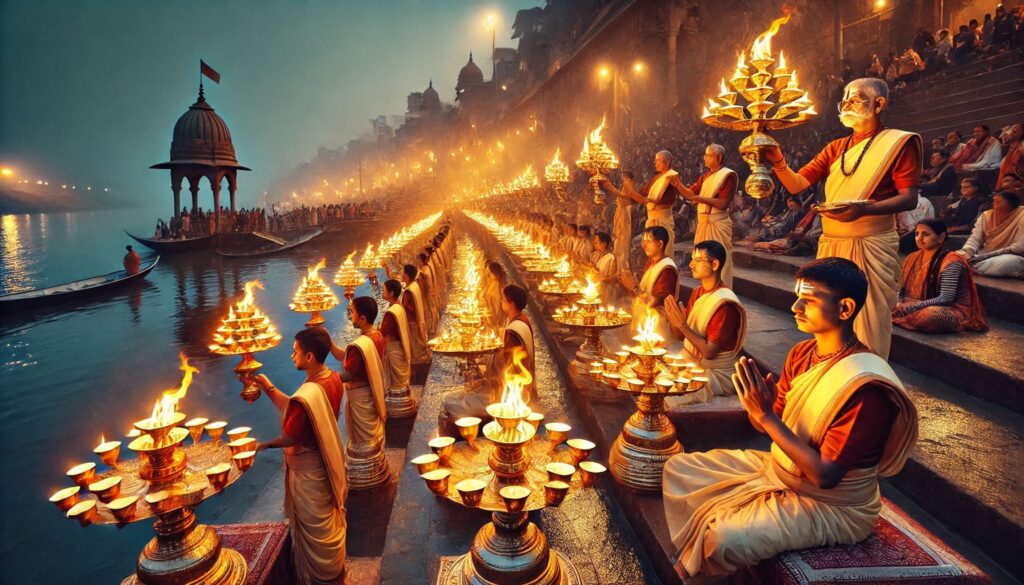Om Jai Gange Mata, Shri Jai Gange Mata.
Jo Nar Tumko Dhyata, Manvanchhit Phal Pata.
O Mother Ganga! Glory to you, your greatness is unparalleled. Whoever worships you with devotion achieves all their desired wishes. Your grace brings peace and happiness to their life.
Chandra Si Jyot Tumhari, Jal Nirmal Aata.
Sharan Pade Jo Teri, So Nar Tar Jata.
Your radiance is as calm and bright as the moonlight. Your water is ever-pure and sacred. Whoever seeks refuge in you is freed from worldly sufferings and crosses the ocean of life.
Putra Sagar Ke Tare, Sab Jag Ko Gyata.
Kripa Drishti Tumhari, Tribhuvan Sukh Data.
You redeemed King Sagar's 60,000 sons, and this is known throughout the world. Your grace brings peace and prosperity to the three realms (heaven, earth, and the underworld).
Ek Hi Baar Jo Teri, Sharanagati Aata.
Yam Ki Traas Mitakar, Paramgati Pata.
Whoever surrenders to you even once is freed from the fear of Yamraj (Lord of Death). By your grace, they attain the ultimate liberation (Moksha).
Aarti Maat Tumhari, Jo Jan Nitya Gata.
Daas Wahi Sahaj Mein, Mukti Ko Pata.
Those who sing your Aarti daily with devotion become your true devotees. Such devotees attain liberation effortlessly.
Om Jai Gange Mata, Shri Jai Gange Mata.
Jo Nar Tumko Dhyata, Manvanchhit Phal Pata.
O Mother Ganga! Your blessings are infinite. Whoever worships you receives all their desired fruits. Your glory is eternal.
Ganga Aarti Timing
The timing of Ganga Aarti varies depending on the location and season. Generally, it is performed in the morning and evening. Below are the timings for some key locations:
1. Haridwar (Har Ki Pauri):
- Morning: Around sunrise (approximately 5:30 to 6:00 AM).
- Evening: Around sunset (6:00 to 7:00 PM in summer and 5:00 to 6:00 PM in winter).
2. Varanasi (Dashashwamedh Ghat):
- Evening Aarti:
- Summer: 6:30 to 7:30 PM.
- Winter: 5:30 to 6:30 PM.
- Evening:
- Summer: 6:30 to 7:30 PM.
- Winter: 5:30 to 6:30 PM.
What Happens During Ganga Aarti?
- Grand brass lamps are lit and priests perform the Aarti with synchronized movements.
- The sound of conches, mantras, and devotional hymns fills the air.
- Devotees gather to express their reverence, and the entire atmosphere feels divine and serene.
About Mother Ganga
Origin and Significance
- The Ganga is considered the holiest river in Hinduism. It is believed to have originated from the feet of Lord Vishnu and was brought to earth by Lord Shiva, who held her in his matted locks.
Geographical Location
- The Ganga originates from the Gangotri Glacier in Uttarakhand at Gaumukh. It flows through Uttar Pradesh, Bihar, Jharkhand, and West Bengal before emptying into the Bay of Bengal.
Religious and Cultural Importance
- Ganga water is regarded as sacred and used in religious rituals and ceremonies.
- It is known as “Mokshadayini” (the giver of salvation) and is believed to cleanse sins and grant liberation.
- Prominent pilgrimage sites along the Ganga include Haridwar, Varanasi, Prayagraj (Allahabad), and Gangasagar.
Mythological Story
- Ganga descended to earth to purify the 60,000 sons of King Sagar, who had been cursed. King Bhagirath performed intense penance to bring her down, earning her the name “Bhagirathi.”
Cultural Contribution of the Ganga
The Ganga is not merely a river but the lifeline of Indian civilization and culture. It is called “Jeevan Dayini” (life-giver) and “Mokshadayini” (liberator). Its worship, conservation, and purity are responsibilities that everyone must uphold.
